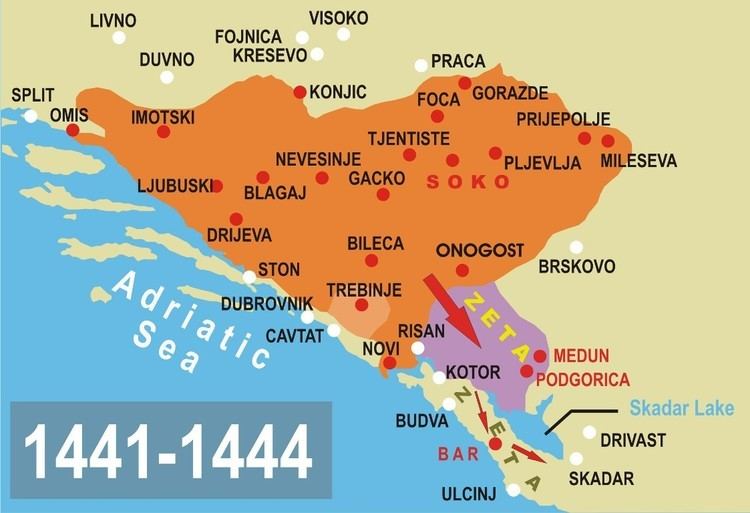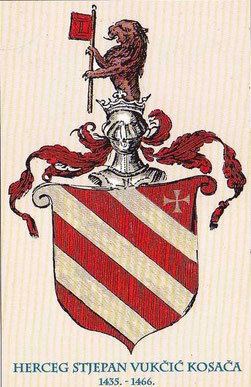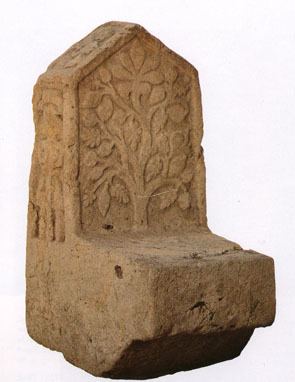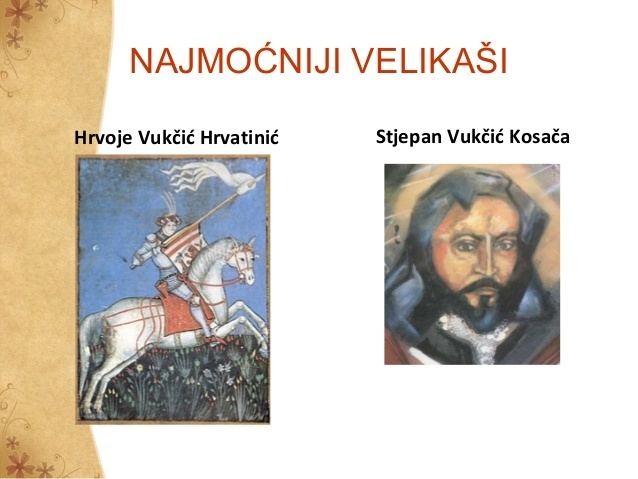Reign 1435—1466 Mother Katarina Father Vukac Hranic Kosaca | Successor Vladislav Hercegovic Predecessor Sandalj Hranic Name Stjepan Kosaca | |
 | ||
Spouse(s) Jelena BalsicBarbaraCecilie | ||
KOSACA - rulers of Herzegovina (English subtitle)
Stjepan Vukčić Kosača (Serbian Cyrillic: Стјепан Вукчић Косача; 1404–1466) was the most powerful and for the most part unruly vassal in the Kingdom of Bosnia. A member of the Kosača noble family, he became Grand Duke of Bosnia upon the death of his uncle Sandalj. He refused to recognize the accession of King Tomaš, proclaiming himself a semi-independent herzog, recognizing the suzerainty first of the Ottoman Empire, then Aragon and again the Ottoman Empire. Peace was briefly restored by the marriage of King Tomaš and Stjepan's daughter Katarina, but it did not last long.
Contents
- KOSACA rulers of Herzegovina English subtitle
- Stjepan vuk i kosa a
- Inheritance
- Civil war
- Peace and royal marriage
- Renewal of conflict
- Ottoman threat
- Issue and legacy
- References

It was Stjepan's title Herceg of Saint Sava that gave rise to the name of Ottoman sanjak established after 1482 when the Kosača family domain fell under Ottoman rule. The name remained since then and it is used for modern region of Herzegovina (Sanjak of Herzegovina was part of the Bosnia Eyalet, while modern Herzegovina is part of modern Bosnia and Herzegovina), and town of Herceg Novi in present day's Montenegro as well.

Stjepan vuk i kosa a
Inheritance

Stjepan was the son of Vukac Hranić Kosača and his wife Katarina, as well as the fraternal nephew of Sandalj Hranić, Grand Duke of Bosnia. Along with his father and uncles Sandalj and Vuk, Stjepan was admitted into the nobility of the Republic of Ragusa by a charter dated 29 June 1419. The same charter granted the family a house in Dubrovnik. Sandalj's father died in 1432, and when his uncle followed him on 15 March 1435, it was Stjepan who inherited the lands and prestigious ducal title, becoming the most powerful vassal of King Tvrtko II of Bosnia.

At the end of September 1441, Kosača captured the territory of Upper Zeta on the left bank of Morača. Stefan Crnojević, who represented the whole Crnojević family, joined him in this campaign and was awarded by Kosača with control over five villages.
Civil war
King Tvrtko II died in September 1443. Being a staunch supporter and adherent of the Bosnian Church, Stjepan refused the recognize the deceased king's cousin and chosen heir Tomaš, a convert to Roman Catholicism, as King of Bosnia. Instead, Stjepan supported Tomaš's exiled brother Radivoj, a candidate also put forward by the Ottoman Empire.
In 1443, the Papacy sent envoys to Tomaš and Stjepan about a counter-offensive against the Ottomans, but the two were in the middle of a war. Ivaniš Pavlović, sent by King Tomaš, attacked Stjepan Vukčić. The King had at the same time been recognized by the Hungarian regent John Hunyadi. Stjepan turned to King Alfonso V of Aragon, who made him "Knight of the Virgin", but did not give him troops. On 15 February 1444, Stephen signed a treaty with the King of Aragon and Naples, becoming his vassal in exchange for Alfonso's help against Stjepan's enemies, namely the King of Bosnia, Duke Ivaniš Pavlović and the Republic of Venice. In the same treaty Stjepan promised to pay regular tribute to Alfonso instead of paying the Ottoman sultan as he had done until then.
Peace and royal marriage
In 1446 the two rivals had made peace. Stjepan Vukčić recognized Tomaš as king, and the pre-war borders were restored. Peace was sealed by the marriage of Stjepan's daughter Katarina and King Tomaš in May 1446, with Catherine converting to Roman Catholicism. The Ottomans were displeased with the peace as their interest lay in dividing Bosnia. Despot Đurađ Branković was also displeased due to Srebrenica issue. In 1448, the Turks sent an expedition to plunder King Tomaš's lands, but they also plundered Stjepan Vukčić's lands. Stjepan Vukčić sent envoys to Đurađ Branković, Despot of Serbia, to try to improve the relations between the two. Vukčić then joined forces with Despot Đurađ and fought Bosnian forces.
Renewal of conflict
The same year Stjepan Vukčić assumed the title "Herzog of Hum and the Coast", dropping "Duke of Bosnia". A year later, in 1449, he had changed it into "Duke of Saint Sava", after the Serbian saint whose relics lay in Mileševa in the east of his province. This title had a considerable public relations value since Sava's relics were considered miracle-working by people of all Christian faiths in the region and tied in with a boost of relations between him and Đurađ Branković; that same year a war broke out over the rich mining town of Srebrenica between Despot Đurađ and King Tomaš, in which Stjepan sided with Đurađ Branković.
In 1451 Stjepan Vukčić attacked Ragusa, and laid siege to the city. As he had earlier been made a Ragusan nobleman, the Ragusan government now proclaimed him a traitor. A reward of 15,000 ducats, a palace in Dubrovnik worth 2,000 ducats, and an annual income of 300 ducats was offered to anyone who would kill him, along with the promise of hereditary Ragusan nobility which also helped hold this promise to whoever did the deed. The threat seems to have worked, as Stjepan abandoned the siege. After Bosnian king Stephen Thomas and the Serbian despot reconciled, the Republic of Ragusa proposed a league against Duke Stjepan. Thomas' charter from 18 December 1451, apart from the theoretical ceding of some of Duke Stjepan's territories to Ragusa (he firmly held those), also included the obligation that he would attack Stjepan.
Ottoman threat
In the early 1460s, Herzog Stjepan controlled of all of today's Herzegovina as far north as Glamoč, but Nevesinje and Gacko were under the control of the Ottoman Empire. Kosača knew he would soon face Ottoman attack so he asked Venetians to allow Skanderbeg's forces to cross their territory to help him. Venetians allowed Skanderbeg to cross their territory to help Kosača, but Skanderbeg failed to carry out his promises. When his son-in-law the King died in 1461, he was succeeded by his elder son Stjepan rather than Sigismund, his son by Queen Katarina. This time, aware of the Ottoman threat, Stjepan did not dispute the succession.
After taking the Kingdom of Bosnia in 1463, Mahmud Pasha also invaded Herzegovina and besieged Blagaj, after which Stjepan conceded a truce by sending his youngest son as a hostage to Istanbul, and ceding all of his lands to the north of Blagaj to the Empire.
Stjepan Vukčić died in 1466, and was succeeded by his eldest son Vladislav Hercegović.
Issue and legacy
Stjepan Vukčić was married three times. In 1424, he married Jelena, daughter of Balša III of Zeta (and granddaughter of his aunt, Jelena Balšić). His wife died in 1453. Two years later, he married Barbara (possibly del Balzo). She died in 1459. His final marriage, in 1460, was to a German woman named Cecilie.
With his first wife Jelena, he had at least four children:
Stjepan and his second wife Barbara had a short-lived son (born in 1456) and a daughter named Mara.
In 1482, Vladislav Hercegović was overpowered by Ottoman forces led by his brother, Hersekzade Ahmed Pasha. Herzegovina was organized into a province (the Sanjak of Herzegovina), which later became one of the sanjaks of the Bosnia Eyalet (1580).
